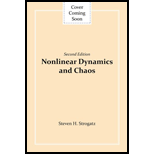
Interpretation:
In special case of rock-paper–scissors cycle for
Byconsideringa subset of the set in (a), defined by
To show that the boundary of Tconsists of three fixed points connected by threetrajectories, all oriented in the same directionand hence, it is a heteroclinic cycle. (Cyclic graph.)
To show that,
To show that
To explain why the previous results mean that, for
To show that for
Concept Introduction:
Fixed point of a differential equation is a point where,
Nullclines are the curves where either
Vector fields in this aspect represent the direction of flow and whether flow is going away from fixed point or coming towards it.
Phase portraits represent the trajectories of the system with respect to the parameters and give qualitative idea about evolution of the system, its fixed points, whether they will attract or repel the flow etc.
Answer to Problem 12E
Solution:
It is shown that E1 is no longerconserved everywhere, but it isconserved if attention is restricted if to the set where
It is shown that Tis also invariant and its shape is triangle.
It is shown that the boundary of Tconsists of three fixed points connected by threetrajectories, all oriented in the same direction, hence it is proved that it is a heteroclinic cycle.
It is shown that
It is explained why interior fixed point attracts all trajectories interior to the T.
It is shown that for
Explanation of Solution
(a)
System is given as,
While
Differentiating E1,
Now, Substituting
Substituting
Above expressions tells that
(b)
To find the subset of the system equation, set
Differentiating it,
Substituting value of
It is only possible if
(c)
From (b), considered the lines connecting three fixed points in the system of equations are,
Let the function
Substituting
Differentiating,
Substituting for
To calculate fixed point, substitute
As there is no S term in
Substituting
Therefore, the system has one fixed point for the lineofequation
(d)
To prove the relation
It is given that,
Differentiating
Substituting
Again substituting
Therefore, for the boundary of
Hence, it is proved.
(e)
To calculate the fixed point,
Now, consider
Substitute
Therefore, from the above calculation, it is clear that the function
(f)
From (e), the fixed point for the above system of equations for
Therefore, for that fixed point the interior fixed point attracts all the trajectories on the interior of
(g)
For the nature of the trajectories for the above system of equationsat
In above expression, if
Fixed points are found and phase portraits, and
Want to see more full solutions like this?
Chapter 7 Solutions
Nonlinear Dynamics and Chaos
- (a) How do Gaussian elimination and Gauss-Jordan elimination differ? (b) Use Gauss-Jordan elimination to solve the linear system in part 3(d).arrow_forwardElectricity By using Kirchhoffs Laws, it can be shown that the currents I1, I2 and I3 that pass through the three branches of the circuit in the figure satisfy the given linear system. Solve the system to find I1, I2 and I3. {I1+I2I3=016I18I2=48I2+4I3=5arrow_forward
- Algebra & Trigonometry with Analytic GeometryAlgebraISBN:9781133382119Author:SwokowskiPublisher:Cengage
 Algebra and Trigonometry (MindTap Course List)AlgebraISBN:9781305071742Author:James Stewart, Lothar Redlin, Saleem WatsonPublisher:Cengage Learning
Algebra and Trigonometry (MindTap Course List)AlgebraISBN:9781305071742Author:James Stewart, Lothar Redlin, Saleem WatsonPublisher:Cengage Learning College AlgebraAlgebraISBN:9781305115545Author:James Stewart, Lothar Redlin, Saleem WatsonPublisher:Cengage Learning
College AlgebraAlgebraISBN:9781305115545Author:James Stewart, Lothar Redlin, Saleem WatsonPublisher:Cengage Learning


